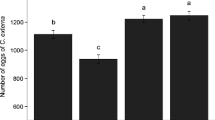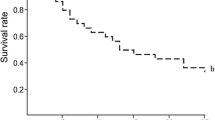Abstract
The capture of prey by last instar larvae of the aphidophagous coccinellidHarmonia axyridis Pallas (Col.,Coccinellidae) modified larval movement so that extensive search was replaced by intensive search. The continuous rearing of this species on eggs ofEphestia kühniella Zell. (Lep.,Pyralidae) or on the aphidAcyrthosiphon pisum Harris (Homopt.,Aphidae) led to conditioning. Only larvae that ate the same prey as they were reared on, adopted intensive searching movements after feeding. Using larvae reared on substitute prey in biological control systems may decrease the efficiency of the released predators.
Résumé
Chez les larves de dernier stade de la coccinelleHarmonia axyridis Pallas (Col.,Coccinellidae) l'ingestion d'une proic entraîne une modification du comportement locomoteur: la recherche extensive est remplacée par la recherche intensive. L'élevage permanent de cette espèce sur une proie particulière, les œufs d'Ephestia kühniella Zell. (Lep.,Pyralidae) ou, le puceronAcyrthosiphon pisum Harris (Homop.,Aphidae) aboutit, au travers de l'apprentissage, à un conditionnement trophique. Seules les larves qui reçoivent une proie identique à celle de l'élevage, abandonnent la recherche extensive et adoptent la recherche intensive. L'utilisation en lutte biologique contre les pucerons de larves produites sur la proie de substitution peut se traduire par une diminution de leur efficacité prédatrice.
Similar content being viewed by others
References
Bell, W. J.—1985. Sources of information controlling motor pattern in arthropodes local search orientation.—J. Insect Physiol., 31, 837–847.
Bell, W. J.—1990. Searching behavior patterns in insects.—Annu. Rev. Entomol., 35, 447–467.
Benzecrii, J. P. &Benzecri F.—1979. La pratique de l'analyse des données, t. 1: Analyse des correspondances, exposé élémentaire.—Dunod, Paris.
Daumal, J., Voegele, J. &Brun P.—1975. Les trichogrammes. II. Unité de production massive et quotidienne d'un hôte de substitutionEphestia kuhniella Zell. (Lep.,Pyralidae).—Ann. Zool. Ecol. anim., 7, 45–59.
Delcomyn, F. &Cocatre-Zielgen, J. H.—1988. Individual differences and variability in the timing of motor activity during walking in insects.—Biol. Cybern., 59, 379–384.
Drost, Y. C., Lewis, W. J. &Tumlinson, J. H.—1988. Beneficial Arthropod behavior mediated by airborne semiochemicals. Influence of rearing method, host plant and adult experience on host searching behavior ofMicrolitis croceipes (Cresson), a larval parasitoid ofHeliothis.—J. Chem. Ecol., 14, 1607–1616.
Clément, P. &Luciani, A.—1985. Un système de trajectométrie automatique pour étudier la nage d'animaux planctoniques (Rotifères).—Vehr. Inter. Verein. Limnol., 22, 3002–3006.
Coulon, P. &Charras, J. P.—1983. An experimental system for the automatic tracking and analysis of rotifer swimming behavior.—Hydrobiologia, 104, 197–202.
Eibl-Eibesfeldt, I.—1970. Ethology, the biology of behavior.—New York:Holt, Rinehart, Winston.
Ettifouri, M. &Ferran, A.—1992. Influence d'une alimentation préalable et du jeûne sur l'apparition de la recherche intensive des proies chez la coccinelleSemiadalia undecimnotata.—Ent. exp. appl. 65: 101–111.
Ferran, A. & Ettifouri, M.—1993. Tactics of movements before and after feeding in larvae ofSemiadalia undecimnotata (Col.,Coccinellidae): a study by automatic tracking.Anim. Behav. (in press).
Houck, M. A.—1986. Prey preference inStethorus punctum (Col.,Coccinellidae).—Environ. Entomol., 15, 967–970.
Kaas, J. P., Elzen, W. &Ramaswamy, S. B.—1990. Learning inMicroplitis croceipes Cresson (Hym.,Braconidae).—J. Appl. Ent., 109: 268–273.
Lerman, I. C.—1981. Classification et analyse ordinale des données.—Dunod, Paris.
Murakami, F. &Tsubaki, Y.—1984. Searching efficiency of the ladybeetleCoccinella septempunctata L. (Col.,Coccinellidae).—J. Ethol., 2, 1–6.
Nakamuta, K.—1984. Aphid body fluid stimulates feeding of predatory ladybeetleCoccinella septempunctata. L. (Col.,Coccinellidae).—Appl. Ent. Zool., 19, 123–125.
Nakamuta, K.—1985. Mechanism of the switch over from extensive to intensive area-concentrated search behavior of the ladybeetleCoccinella septempunctata bruckii.—J. Insect Physiol., 31, 849–856.
Obata, S.—1986. Mechanism of prey finding in the aphidophagous ladybird beetleHarmonia axyridis Pallas (Col.,Coccinellidae).—Entomophaga, 31, 303–311.
Storch, R. H.—1976. Prey detection by four stageCoccinella transversoguttata larvae (Col.,Coccinellidae).—Anim. Behav., 31, 303–311.
Stubb, M.—1980. Another look at prey detection by coccinellids.—Ecol. Entomol., 5, 179–182.
Thorpe, W. H.—1956. Learning and instinct in animals.—London:Methuen.
Vinson, S. B.—1976. Host selection by insect parasitoids.—Ann. Rev. Entomol., 21: 109–133.
Wardle, A. R. &Borden, J. H.—1985. Age-dependent associative learning byExeristes roborator (F.) (Hym.,Ichneumonidae).—Can. Entomol., 117, 605–616.
Visser, J. H.—1986. Host odor perception in phytophagous insects.—Ann. Rev. Entomol., 31, 121–144.
Author information
Authors and Affiliations
Rights and permissions
About this article
Cite this article
Ettifouri, M., Ferran, A. Influence of larval rearing diet on the intensive searching behaviour ofHarmonia axyridis [Col.: Coccinellidae] Larvae. Entomophaga 38, 51–59 (1993). https://doi.org/10.1007/BF02373138
Received:
Accepted:
Issue Date:
DOI: https://doi.org/10.1007/BF02373138




